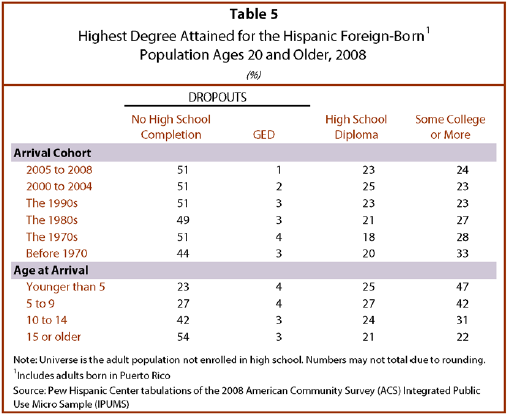Hispanic immigrants are one of the country’s least educated populations. More than half of Hispanic immigrants do not have at least a high school diploma (52%), twice the rate of native-born Hispanics (25%). As Table 5 shows, more recently arrived immigrant Hispanic adults are not much better educated than Hispanic immigrants who have been in the United States for decades.5 With the exception of adults who arrived before 1970, a majority of immigrant Hispanic adults in 2008 were high school dropouts.
The relatively poor education of Hispanic immigrants reflects the fact that most Hispanic immigrants are educated not in the U.S. but in less developed countries. Hispanic immigrants who arrived in the U.S. early in childhood and thus were enrolled in U.S. elementary and secondary schools are much better educated. Of those who arrived under the age of 10, only about one-quarter were high school dropouts in 2008, and their education approximates that of native-born Hispanic adults (Table 5). Most immigrant Hispanic adults arrived in the United States after age 14 (80%), and a majority of them were high school dropouts.
Despite their high dropout rates, Hispanic immigrants have low levels of GED credentialing. Only 3% of Hispanic immigrants have GEDs, compared with 4% for the entire U.S. adult population. Hence, the potential for Hispanic immigrant dropouts to improve their lot through further postsecondary education and training is very limited because they lack the required credential.
There is some evidence, though, that as Hispanic immigrants spend more time in the United States, their skills and education improve. For example, immigrants’ English language proficiency improves with duration of residence (Chiswick and Miller, 1998). Many adult immigrants are enrolled in school, and their educational attainment increases as they spend more time in the United States (Betts and Lofstrom, 2000).
Though there is only suggestive evidence, it does appear that Hispanic immigrants increasingly obtain GEDs the longer they reside in the United States.6 Table 5 indicates that only 1% of recently arrived immigrants have a GED. Among those who have been in the United States for 10 years or more, at least 3% have a GED. So with more time in the United States, more Hispanic immigrants may acquire GEDs.





